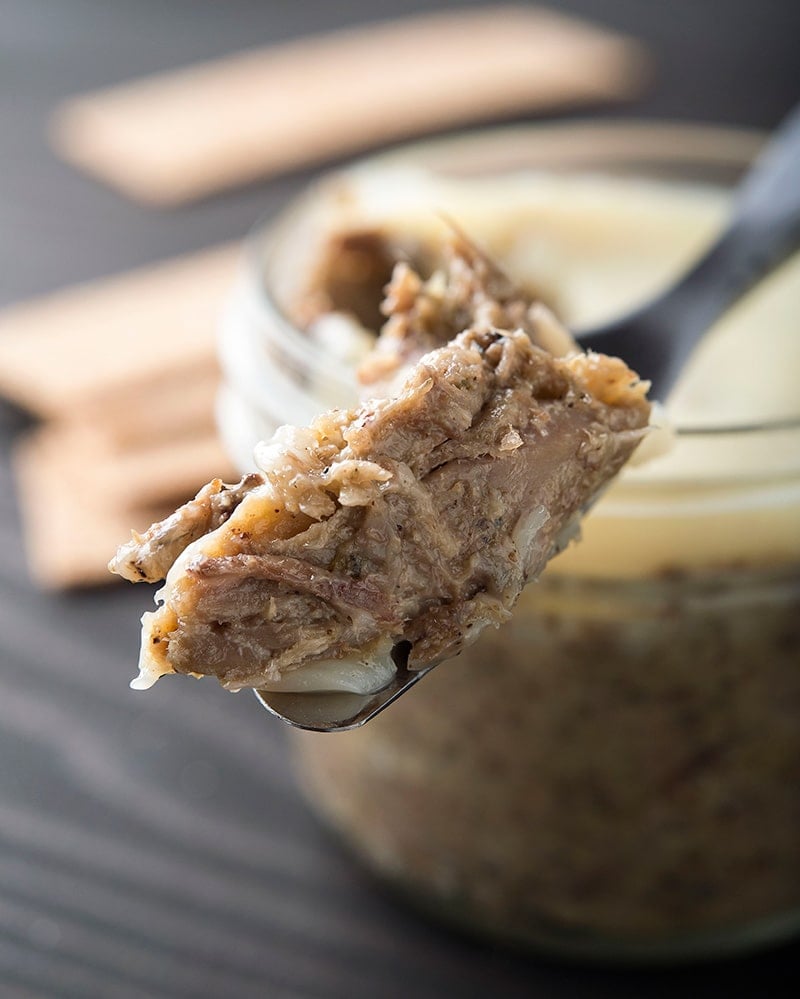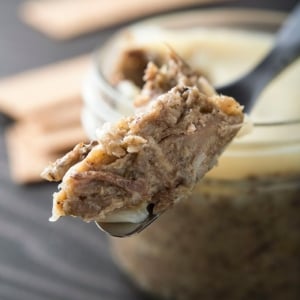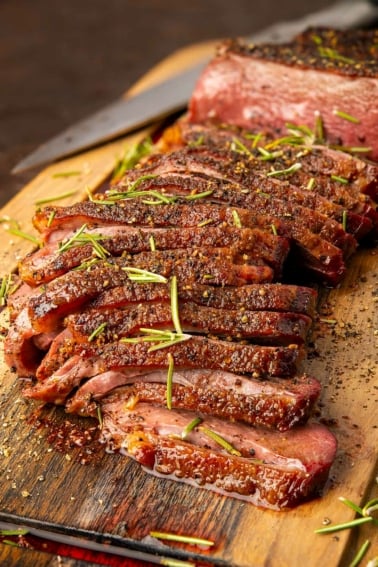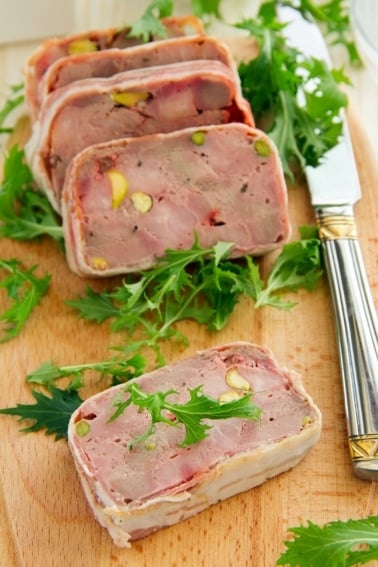As an Amazon Associate I earn from qualifying purchases.

Duck rillette. If you know what this is, you definitely know your food. If you don’t, think of it as a fancy way to say “potted meat.” See the difference? I’d eat “rillette.” Potted meat evokes images of SPAM and other industrial horrors.
A rillette is basically a preserved, fatty meat product pulverized enough to be spread on bread. Some are smooth, some coarse. It is a great use for meats that are very tough, yet very flavorful. The French typically make rillettes from pork or duck or goose or rabbit.
My duck rillette is unlike anything you will find in a can, or in France. These are made from either duck or goose legs and wings. The fat is wild duck fat, and it is seasoned with Armagnac and rue — yes, rue, that bitter herb possessed with a beguiling aroma. The combination works, and works well.
Wild geese are darker and stronger tasting than a domestic geese, but not overly so. There is a definite wild taste to it, which I enjoy very much. The wild duck fat accentuates this; if you wanted to subdue a wild goose’s wildness, you could use butter or fresh rendered lard instead.
The Armagnac subs in for Cognac or other brandy because, I feel, Armagnac is better suited to wild game. If I did not use it, I might sub in Maker’s Mark or another quality American whiskey.

Finally the rue. Rue’s aroma is musky and thought-provoking: “What is this,” you think…”I want to smell it again and again.” Rue’s flavor is bitter. The Romans used it in their cooking, but you will find few modern recipes employing this herb. Using rue here adds to the rillettes’ aroma and cuts into the deep richness of the meat and fat. If you don’t have it, use parsley.
Why make rillettes? If you are a hunter, it is a fine use for the meat from legs and wings; you can even do this with legs and wings that have been skinned. And whether you hunt or not, rillettes are a fantastic appetizer or snack, spread over crusty bread and served with pickles.
What’s more, a duck rillette (or any rillette) keeps forever. Since the meat is presalted, kept from air by the fat (you need to cover the top with a layer of fat for long keeping), and helped by the preserving nature of the alcohol and herbs, you can keep rillettes for many months in the fridge.
Duck or Goose Rillettes
Ingredients
- 3 pounds duck or goose legs or wings
- 1 cup Kosher or pickling salt
- 3 tablespoons dried thyme
- 2 quarts duck or vegetable stock
- 3 bay leaves
- 1 cup duck fat or butter
- 1/4 cup brandy
- 1 tablespoon minced rue or 2 tablespoons parsley
Instructions
- Start by mixing the thyme leaves and salt. Massage this mixture into the duck or goose legs, making sure everything is coated well. If there is any left over, pour it into a non-reactive container.
- Place the salted duck or goose legs in the container, cover and refrigerate for 12-24 hours. The longer you go, the saltier your rillettes will be. I like to salt them down in the evening and cook them around mid-day the following day.
- When you are ready, rinse off the cure well. Arrange the legs in a large pot and cover with the duck stock; add water or white wine if the level of the liquid does not cover the legs. Add the bay leaves.
- Cover, then either cook on the stove over low heat or in a 225 degree oven for 4-8 hours. You want the meat to be falling off the bone. Check after about 2 hours to see if you have enough liquid. Uncover the pot in the final hour or two to evaporate the liquid a bit.
- When the meat is falling off the bone, turn off the heat and let the duck or goose legs cool. Ideally, you refrigerate everything to solidify any fat (you can use it later).
- When it is cool, pull off the skin and discard, then shred the meat and place in a large bowl.
- Taste the remaining stock to see how salty it is. You will need a little for the rillettes, but you want to know how much to add — without oversalting the rillettes.
- Add a little of the stock to the rillettes and beat together with a stout wooden spoon until the liquid is incorporated.
- Add 2 tablespoons of the duck fat and beat it in. Keep adding duck fat until the mixture becomes creamy. Do this little by little.
- When a spoonful of the rillettes tastes creamy, not dry-ish, add 2 tablespoons Armagnac and half the rue. Beat it in well. Taste it: You should be able to taste both the Armagnac and the rue, but neither should be overpowering. If you want, add the remainder of the liquor and herbs and beat them in well.
- Press the rillettes into ramekins, or just a non-reactive container that works. Tupperware is OK, and a butter crock is ideal. Top with about 1/4 inch of duck fat. Cover with a lid or foil and store in the fridge. It is best to let this ripen for a week before serving, but it is perfectly fine eaten straight away. It’ll keep for at least two months, and if there are no air pockets and it is covered in fat, the rillettes will last up to 6 months.
Nutrition
Nutrition information is automatically calculated, so should only be used as an approximation.





What would you suggest as a substitute if one didn’t have enough wild duck fat?
Scott: Freshly rendered lard, available at Latin markets (or you can make it yourself), or you can buy duck fat in fancy supermarkets, or just use good butter.
Dave — is there any reason why covering with olive oil instead of animal fat will not work.
Rhoula: Yes. The olive oil won’t solidify.
Hi Hank, Will these keep in the freezer like the salmon rillettes?
Dave: Yes.
Hello Hank,
I cook a whole duck in a slow cooker for about 6 -8 hours and then strip the meat off. I allow the carcass to slow cook with the skin for at least 24 hours to make a broth. When the broth is done I strain the liquid and am left with enough meat to make rillettes…well it looks like rillettes already in consistency without having added any alcohol or herbs. Do you think this would be a good basis for making rillettes?
Thanks!
Catherine: Sounds like it would work fine.
Hank, can you give me an estimate on the meat weight of 18 duck legs, so as to be able to substitute breast or liver? Also, could I add a bit of cure #1? For color, that is…
Thanks!
Charlie: Yep. you can add a little No. 1 cure. AS for weight, it’s approximate, but I’d say about 3 pounds. Wild duck legs are small.
Chris: I honestly have no idea, as I’ve never made venison rillettes. But this recipe ought to be a better base for that than a rabbit recipe because goose is red meat like venison. Good luck, and let me know how it turns out!
The Fatted Calf mentioned this in a tweet the other day because I asked their opinion and they said you would have some good ideas:
What do you think the best way is to go about making venison rillettes? I have the Ruhlman/Polcyn book and the Fatted Calf. Was thinking of using the Fatted Calf’s rabbit rillettes as a base recipe. Your thoughts?
I am in england where we do not have snow geese but over here RUE is regarded as poison. We do have lots of other herbs so I will try one of them.
Awesome, thanks! What about for your sausage recipes? In other cooking where wine is called for I mix grape juice, water and vinegar in imprecise 3:3:1ish ratio; usually comes out sweeter than I would like, but them’s the breaks.
Am fixing to make some uncased sausage for the duck pie…
P.S. Confit turned out fantastic!
Dan: You can skip the alcohol. It’s mostly for flavor, although it does provide some extra preservation effects.
Sounds fantastic (as most of your recipes do–so glad I found your site!). Only problem is we can’t use alcohol. Is it necessary for the preservation or just for the flavor? If the latter (which I hope since I notice the shad rillettes don’t have it) will look forward to experimenting to get a good flavor without it.
Thanks for the fantastic recipes! My first attempt at confit is almost finished as I type and I can’t wait for the goose season to open up again in a few days to hopefully get some more Canadas to cook. Cheers!
Last summer we went to an auberge meal at a duck farm and they served rillettes and my husband is crazy about it now. They brought us crusty/ stale bread, maybe lightly toasted, and garlic cloves cut in half. You take the open half of the garlic clove and rub it over the rough surface of the bread before you spread the rillettes and it is heavenly.
Just thought I would pass that along.
Some farmers shot wild snow geese and gave me a couple, I plucked & gutted & roasted them but they were a lttle tough. I’ll try your rillettes recipe except I’ll chop it and shred it so it dos’nt resemble cat food to much
Matt: Yep, I grow rue, as NorCal Cazadora can attest (and yes, Holly, scars ARE sexy!) I braise it instead of confit the meat because I happened to have lots of good duck stock handy — and because stock adds more flavor than fat, IMHO.
Sylvie: Nothing wrong with eating rue in small amounts, although it is bitter. I like the idea of juniper; maybe I’ll do that with wild boar rillettes.
Nick: You’re in Sacramento, right? Meet me downtown and I can bring you some rue. I can almost guarantee you can’t find it for sale outside of a nursery. Most people don’t know you can eat it.
Yeah that rue sounds interesting, any suggestions on how one can acquire some? Also if anybody has not had rillettes before, you are missing out. One of my favorite restaurants in Oakland, Dopo, frequently serves pork rillettes, in place of butter, with bread. Great stuff!
This sounds like the kind of stuff foodies would literally kill for. Boy does it sound good.
OK, I have to make my obligatory statement about rue, which grows all over our yard now because it volunteers like crazy: Don’t touch it when it is (or you are) wet – it will give you a nasty rash.
I found out the hard way when I was pulling weeds in the summer. I was sweaty as hell, and when I leaned over the rue, I got too close and it brushed against my chest. It never itched, but it bubbled up like poison oak/ivy, and six months later I still have a scar.
It’s a very intriguing scar, though – shaped like a scorpion – so at least it adds to my sex appeal. At least, that’s my story…
Rillettes is the only thing I have done so far with wild geese (still have some breasts in the freezer to try some your sausage recipes as you suggested earlier). I don’t pickle them though, and my herb of choice is juniper berries. I am not sure I would ingest rue… but I do like its scent (some people find it unpleasant – the same people who don’t like radicchio or arugula…), and the its lovely blue green leaves. I would not do without the Herb of Grace in the garden.
I like the salting idea, makes sense it would help to preserve the meat longer.
Sylvie
https://www.LaughingDuckGardens.com/ldblog.php/
Sylvie
I saw Rillettes in the title of this post and simply had to read it! I love rillettes. I could spread them on crostini like peanut butter every day and be a happy girl!
I’ve had rabbit and duck rillettes–your spin sounds unique and wonderful. I’ll be right there 😀
Lovely, lovely stuff. I have never come across rue before – I am guessing you must grow that.
Talk about a lovely looking rillette too. Sure, they all look like cat food, but that is where the similarity ends!!
Out of interest, why not confit the legs rather than simmer in stock?